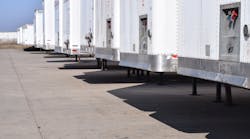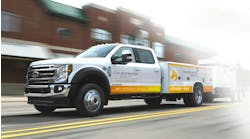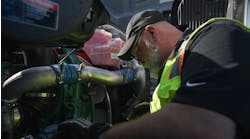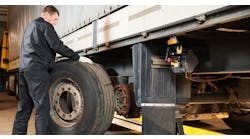I recently had the opportunity to visit a national drugstore chain’s maintenance facility run by contracted service provider Transervice Logistics, for some insight while researching the story When does it make sense to outsource maintenance?
For this retailer, Transervice oversees on-site maintenance for the 3,350 leased pieces of equipment at 16 different distribution center locations, all running a similar dedicated maintenance operation to the one I visited.
Assistant Vice President Gino Fontana, who oversees all contracted services for this retailer on behalf of Transervice, gave me the grand tour of the facility in southcentral Wisconsin.
It gave me perspective on understanding that dedicated contract maintenance facilities are really just like any other maintenance facility. But, I also got details on the types of benefits contracted on-site maintenance can provide a medium- to large-sized fleet.
Similar operations
The location I visited provided insight into the day-to-day operations of a contracted maintenance facility. And, it looks like any other maintenance facility you might expect.
Operations manager Clint Starin, who has worked for Transervice more than 20 years, oversees three shops in three different states – Wisconsin, Illinois and Ohio. And even though those locations are all in the Midwest, the microclimates for each location still require some unique maintenance approaches.
“Wisconsin versus southern Illinois, you wouldn’t think it’s a big deal, but the climate is a lot different,” Starin says. “They get snow a couple times a year. Up here, it’s a lot more. There’s a huge difference.”
“These guys are trying to bring a set of standardized approaches to a world that has a lot of dynamics,” Fontana adds, of the different Transervice locations. “They’re just trying to ... provide the same level of service regardless of location.”
It’s also true that different areas of the country require different equipment and component spec'ing and maintenance practices. Some examples of changes they’ve made at the Wisconsin location include:
Comprehensive wheel program – For this Midwest location, Starin worked with Michigan-based A2G Wheels to include a protective synthetic Corsol coating on wheel ends through a polymer galvanization process.
“If you sent them out to a wheel guy, they would sandblast them and powder coat them,” Starin says. “We usually would get a year out of them. These, they put a five-year warranty (used) or 10-year warranty new. I’ve had very little warranty issues.”
Updates to trailers – For the Wisconsin-based fleet trailers, Transervice added a galvanized frame and cross members to help combat corrosion. In addition, the fleet spec’d a quick-removal frame system on trailer sides, from Kwik-Zip, which allows the fleet to easily change out the message on the sides of trailers.
Fontana says the customer expressed interest in tracking trailer assets, and Transervice assisted with finding the right vendor and coordinating the install. “We helped identify the right vendor and had them come in on the weekend while the trailers were here,” he explains.
Coolant warmer – This location recently added a Webasto coolant heater for quicker engine warm-ups, especially during winter months. “Instead of plugging the trucks in in the winter, you can turn these on from the cab,” Starin says. “It’s a little boiler, basically. It warms up the coolant before you operate the truck.”
Training focus
Like many fleet maintenance facilities, this operation focuses on comprehensive training for its technicians to both to ensure service consistency, and to properly diagnose issues.
“It’s one thing to change a part. If a battery in the truck is dead, you change the battery,” Fontana says. “But why did it die? Drilling down into those root causes is where you can save the customer some money, and keep the truck on the road. If you didn’t fix the root cause, the next battery is going to die and the truck will break down. It’s another road call, it's more money.”
Due to the complexity of vehicles and equipment, Fontana advises technician skillsets are becoming more of a hybrid between generalist and specialty. All technicians have the ability to work on numerous areas of the tractor or trailer, but may also excel or receive additional training in a specific area such as suspension, diagnostics or electrical.
“Technology is a huge piece to try to keep up with and continually train the crew," Fontana says. "We put a big emphasis on it, but it’s not like something where you did it and you’re done. It’s like cutting the grass. Next week, you get to it again. You just have to continue to build on it.”
Advantages in action
In order to make certain the trucks can run during the required times to ensure on-time deliveries, employees at these locations must be flexible with the schedule as to when general maintenance and repairs can be completed. Typically, the maintenance shop is loosely running second shift – with most techs on-hand nights and weekends – to make sure regular maintenance and PMs are completed when the trucks aren’t needed for deliveries.
“They want someone here when they leave, and when they’re coming home,” Fontana explains. “We build our shifts around those three factors: when are you leaving, when are you coming home and when is this (equipment) sitting.”
Transervice makes the decision on the equipment the fleet will run, based on thorough analysis of market options and the needs of the customer. But, Fontana advises this is with full transparency to the customer.
“We’re pretty agnostic when it comes to equipment,” he says. “Every year, we’ll go through a review of what’s happening in the marketplace. We look at how the equipment that’s in service has been performing. We just put in Peterbilts – we’ll look at how they’re doing, what’s the total cost to maintain them, fuel costs, driver acceptance, reliability (breakdowns we’ve been seeing). And we evaluate that.
“Our job is to know the differences with OEs," Fontana continues. "What worked last year, how they did in the field, performance, maintenance, all of that. Then what’s coming up. That’s what we present to the customer.”
Constant feedback
One challenge to outsourcing maintenance to a contract service provider can be maintaining an open dialogue with the fleet manager. Starin works closely with the fleet manager to advise on current issues and provide suggestions on updates.
Building relationships and constant communication with drivers is also critical, because it keeps dialogue open on identifying vehicle issues early on and allows the fleet the opportunity to educate and train drivers on proper procedures and changes.
Fontana confirms Transervice typically works with medium and large-sized fleets looking to have a dedicated maintenance location.
“It really comes down to customers looking to focus on their core business, and leveraging the power of the vendor network, and the buying power we have, and leveraging the expertise,” Fontana says.
“If it’s a detraction from their core business, would you rather put money into expanding your DC or conveyor system, or something that’s going to help your core business? Or, would you rather invest in trying to become an expert in fleet maintenance?”




